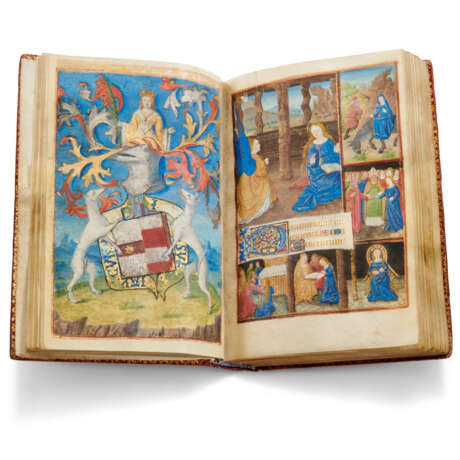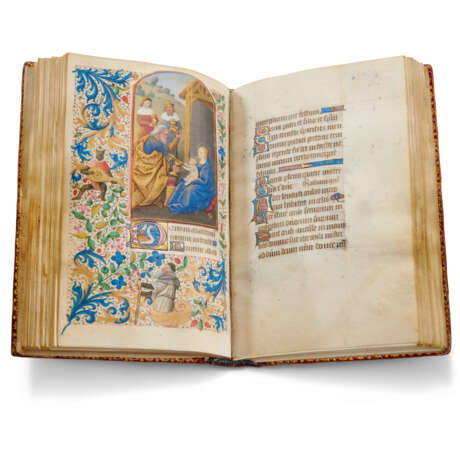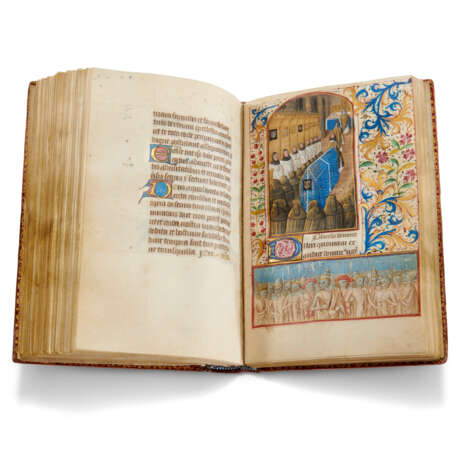ID 794440
Lot 32 | Follower of Jean Colombe
Estimate value
£ 40 000 – 60 000
Book of Hours, use of Saintes, in Latin, illuminated manuscript on vellum [Poitiers?, c.1480 and c.1500]
An engaging Book of Hours for the extremely rare use of Saintes, illuminated with lively and captivating miniatures by artists working in the ambit of Jean Colombe.
162 x 109mm. i (paper)+ i+123+i +i (paper) leaves, collation: 1-26, 39 (of 8, i an inserted miniature), 4-58, 66 (of 8, lacking iv-v), 7-168, modern foliation in pencil followed here, most catchwords survive, 16 lines, ruled space: 83 x 53mm, rubrics in gold or red, text on ff.14 and 63 in burnished gold, capitals touched in yellow, illuminated line-fillers and initials throughout, 14 small miniatures and 13 large miniatures within full borders, including one added full-page frontispiece with coat of arms (lacking one miniature for terce after f.40 and one text leaf, occasional marginal staining, a few minor losses of pigment, e.g. to the blue on the horses on f.63, tear to margin on f.34 neatly repaired, sewing holes where pilgrim badges would have been attached on ff.13 and 123v). Mid-18th-century French red morocco gilt, title ‘Heures Manuscrit’ gilt (spine repaired). Fitted box.
Provenance:
(1) The liturgical use of these Hours, unidentified in the 1987 Sotheby’s catalogue, is in fact Saintes, a commune in Aquitaine (now Charente-Maritime in Nouvelle-Aquitaine), some 40 miles from Angoulême and 80 miles from Poitiers, two major centres of illumination at the end of the 15th century. The Calendar, with St Hilary of Poitiers (13 January ‘Hilarii epi. Pictavec.’) and St Radegund (13 August, ‘Radegundis regine’) in gold, points to Poitiers, and it includes other south-western French saints such as Quiteria, Martial, Clodoaldus, St Martin of Tours and Amanus. The manuscript was prepared in two campaigns: the first was completed in 1480; the second, which occurred around 1500, saw the addition of ff.62-67 and 114-23 with all the smaller miniatures and the heraldic shields in the margins of ff.24, 34 and 53 and in the miniatures proper on ff.68 and 85. The full-page miniature with the coat of arms was added at around this time too.
(2) The coat of arms on f.13 is part per pale 1. argent, a star or on a fesse gules, 2. argent, two bars gules, with the motto (flaked and almost illegible): ‘IAY. CUI. […] SUE’ and supported by greyhounds. The first arms also appear on ff.24, 34, 53, 68 and 85 (on the latter they are on the coffin and along the choir stalls). It was suggested in the Sotheby’s 1987 catalogue that these are the arms of the Massolo family of Venice, and that the second are the arms of the Moggio family of Udine. The first set of arms are also a match for the Witz family of eastern France.
(3) Erased ?19th-century ink bookstamp on f.1 with the Jesuit Christogram.
(4) Sotheby’s, 1 December 1987, lot 68.
Content: Calendar ff.1-12v; Office of the Virgin, use of Saintes, ff.14-62: matins f.14, lauds f.24, prime f.37, terce f.41 (lacking opening), sext f.44v, none f.48v, vespers f.53, compline f.58; Gospel extract ff.62-63v; Obsecro te ff.63v-67; Penitential Psalms and Litany ff.68-84v; Office of the Dead, use of Saintes, ff.85-113v; Suffrages ff.114-123.
Illumination:
The style of illumination in the present manuscript is characteristic of southeastern French illumination from the end of the 15th century. The layout of the miniature with the Annunciation, for example, surrounded on two sides with scenes from the infancy and life of the Virgin, is found in a parallel composition in a Book of Hours sold at Christie’s on 9-30 July 2020, lot 16, attributed to the Dauphiné painter known as the Master of the Apocalypse of Aymar de Poitiers (see F. Avril, N. Reynaud, and D. Cordellier, Les enluminures du Louvre: Moyen Âge et Renaissance, Paris, 2011, pp. 212-16, nos. 107-12), named for an illuminated Apocalypse in Glasgow with the arms of Aymar of Poitiers (University Library, Hunter 398).
But the influences here, in the tonality of colouring and rendering of figures enlivened with liquid gold highlighting, along with the deep receding and evocative settings are much more reminiscent of the work of Jean Colombe of Bourges, an artist most famous for completing the Limbourg brothers’ Très Riches Heures for the Duke of Savoy at the end of his long and prolific career. See, for example, the similarities between the Flight into Egypt in this manuscript (f.53) and a Flight attributed to Jean Colombe sold at Christies' on 15 November 2006, lot 3. Three compositions in this manuscript are particularly striking and point to the inventiveness of our artist: the Nativity (f.37) which is set in pitch darkness with the exception of straight bright beams of light raining down on the figure of the infant Christ (in a manner that is reminiscent of similar scenes by Jean Bourdichon); Bathsheba bathing (f.63), surrounded by riotously violent battle scenes with the death of Uriah; and the funeral scene opening the Office of the Dead (f.85), with its deep receding perspective and marginal panel miniature showing rows upon rows of skeletons wearing cardinals’ hats and papal tiaras.
The subjects of the large miniatures are as follows: Full-page coat of arms f.13v; The Annunciation, with scenes from the infancy and life of the Virgin, f.14; The Visitation f.24; The Crucifixion f.34; Pentecost f.35v; The Nativity f.37; The Adoration of the Magi f.44v; The Presentation in the Temple f.48v; The Flight into Egypt f.53; The Coronation of the Virgin f.58; Bathsheba, surrounded by battle scenes and the death of Uriah f.68; Funeral service f.85; Job on the dungheap f.90.
The smaller miniatures are on ff.62, 63v, 114, 114v, 115, 115v, 117, 118, 118v, 119v, 120, 120v, 121 and 122.
Special notice
No VAT on hammer price or buyer's premium.
| Place of origin: | Western Europe, France, Europe |
|---|---|
| Auction house category: | Medieval & renaissance manuscripts |
| Place of origin: | Western Europe, France, Europe |
|---|---|
| Auction house category: | Medieval & renaissance manuscripts |
| Address of auction |
CHRISTIE'S 8 King Street, St. James's SW1Y 6QT London United Kingdom | |
|---|---|---|
| Preview |
| |
| Phone | +44 (0)20 7839 9060 | |
| Buyer Premium | see on Website | |
| Conditions of purchase | Conditions of purchase |







